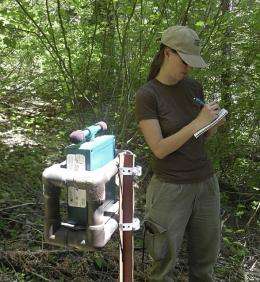Singing in the rain: Technology improves monitoring of bird sounds

Researchers at Oregon State University have created a new computer technology that can listen to multiple bird sounds at one time to identify which species are present and how they may be changing as a result of habitat loss or climate change.
The system, one of the first of its type, should provide an automated approach to ecological monitoring of bird species that is much more practical than a human sitting in the field, hours on end.
"It's difficult to hear and identify even one or two bird species at a time, and when you have many of them singing at once it's even more difficult," said Forrest Briggs, a doctoral student in computer science at OSU.
"Birds are important in themselves, but also an early warning system of larger changes taking place in the environment," Briggs said. "Now we can tell down to the second when a bird arrives, leaves, when and where it's choosing to nest, that type of information. It's just not practical to do that with human monitoring."
The "multi-instance multi-label" machine learning system developed at OSU, researchers said, could ultimately be used to identify not just bird sounds but many other forest noises – everything from wind to rain drops or a falling tree. It could also be used with other animal species, including grasshoppers, crickets, frogs, and marine mammals. The research was supported by the National Science Foundation and the OSU College of Engineering.
"It would not be reasonable for a person to count birds once per minute, 24 hours a day, for three months, but we aim to obtain similar results with acoustic surveys," the researchers wrote in a recent study published in the Journal of the Acoustical Society of America.
The error rate of this technology is already similar to that achieved by human experts, Briggs said. In one day of testing, for instance, it produced 548 10-second recordings of sounds from 13 different bird species. It is also omni-directional, meaning the microphones do not have to be pointed right at the sound in question to function accurately, one of the limitations of some previous technology.
Researchers are still working out some issues, including interference caused by rain, not to mention people heard partying in the woods, and what appeared to be the bite mark of a bear on the microphone.
Journal information: Journal of the Acoustical Society of America
Provided by Oregon State University
















